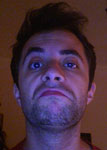-
So after the Observation and the first round of prototypes Ana, Cher and I decided to focus on the hexagonBrush design.
here's the video of the first prototype
hexagonBrush fit very well in our design strategy made of:
PLAY
COLLABORATION BETWEEN STRANGERS
CREATION
COMMUNICATION
AUGMENTING PHYSICAL SPACE
COLLABORATION BETWEEN STRANGERS
CREATION
COMMUNICATION
AUGMENTING PHYSICAL SPACE
The idea came out observing the tiles that were embedded into the floor of Union Square.
These tiles come in hexagonal shape and are arranged in a hexagonal tiling pattern, thus dividing and arranging the ground surface in a very different way than classic square/rectangular tiling, allowing to perceive the space in a different way.
They are also localized just in Union Square area, almost 80% of the square surface is covered with them.
They are also localized just in Union Square area, almost 80% of the square surface is covered with them.
Looking at them we started thinking about their relationship with the pixels we can find on every digital screen and started wondering...
After the first prototype we noticed a number of features of the hexagonBrush to improve and implement :
We observed that people tend to move from place to place if their drawing is very big or to find an appropriate spot.
Enable simultaneous drawings
Add Colors
Liquid instead of powder
A plastic board reference instead of sheets of paper
Make it tougher but still light and fun
Enable the rotation of the brush
Digitally assisted reference
"What if a person can use a tool to fill up with one movement one tile at time with colour?
This can transform the square in a huge, public surface for drawings!"
This can transform the square in a huge, public surface for drawings!"
Well... the fact is that Union Square IS a huge, public surface for drawings, the problems is that people is forgetting it and laws are starting to become more and more severe regarding this practice considering it graffiti or littering.
So we want to create an interface that goes in the opposite direction, allowing people not only to recover their freedom to draw but also to use the whole square as a canvas; children has done this for ages but never with a site specific tool and a reference to plan their designs.
So we want to create an interface that goes in the opposite direction, allowing people not only to recover their freedom to draw but also to use the whole square as a canvas; children has done this for ages but never with a site specific tool and a reference to plan their designs.
After the first prototype we noticed a number of features of the hexagonBrush to improve and implement :
Empower mobility
We observed that people tend to move from place to place if their drawing is very big or to find an appropriate spot.
Enable simultaneous drawings
The ideal setup would be having two brushes so simultaneous collaboration can be achieved.
Add Colors
They supply another layer of expression and are a very powerful communication tool.
Liquid instead of powder
Mixing a bit of water to powder would improve the printing detail of the brush on the tile.
A plastic board reference instead of sheets of paper
A bigger reference is needed for more than one person using it. It should be made of plastic and not paper as it must be reusable.
Make it tougher but still light and fun
People enjoyed the playful look of the interface, but they also broke it, so we have to reinforce it while refining its aesthetics.
A very powerful and not totally expected interaction pattern emerged: people jumped on the brush, resulting in both more fun and more chalk put on the tile, we have to work on this too.
A very powerful and not totally expected interaction pattern emerged: people jumped on the brush, resulting in both more fun and more chalk put on the tile, we have to work on this too.
Enable the rotation of the brush
This feature was not planned in the beginning but came after one very strong interaction by a young kid who started jumping on the brush. The screw that was keeping the brush attached to the pole became loose allowing the brush to rotate.
This enriched the output allowing the following users to trace big circles standing fixed as a pivot point and rolling the brush around them.
This enriched the output allowing the following users to trace big circles standing fixed as a pivot point and rolling the brush around them.
Digitally assisted reference
What if a user wants to make a complex drawing but it's not able enough to do it? It can use a digital reference, going to a website or a digital interface on site, upload the target image of the drawing and get a hexagon-made version of it ready to "render" on the tiles.
-





2 comments:
keep goin' this is great
bella pè!
Post a Comment